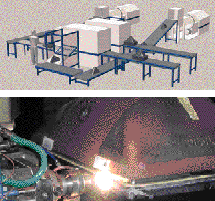
CO2 Laser Recycles Cathode-Ray-Tube Displays
Hank Hogan
Nothing lasts forever. That's especially true for electronics equipment, which not only breaks down, but also becomes obsolete, creating a rising tide of electronic scrap, or "e-scrap." Now Proventia Automation Oy of Oulunsalo, Finland, has developed a laser-based recycling system that promises to divert some of this flood into new products.
According to a 2003 report from the International Association of Electronics Recyclers in Albany, N.Y., approximately 1 billion units of computer equipment will be junked by 2010. In addition, some 200 million televisions will be discarded each year for the rest of the decade. Most of this e-scrap includes a cathode-ray-tube display, a component with potential for recycling.

A system based on CO2 lasers targets the recycling of cathode-ray tubes. Courtesy of Proventia Automation Oy.
Specifically, up to 95 percent of the materials in an 85-lb television monitor can be reused to manufacture new units. In particular, there are the panel glass, which sits in the front of the cathode-ray tube, and the funnel glass, which is behind and bonded to the panel glass. The funnel glass is approximately 25 percent lead and contains some graphite and other materials.
Accordingly, the challenge has been to find a means of separating these glass components for recycling and reuse without contaminating everything with lead. One approach has been to tackle disassembly manually, which can take as long as five minutes per cathode-ray tube. Recyclers combine the various glasses in a smelting process that yields a mixture of limited use in manufacturing displays and other products. Because it is difficult to ensure strict confinement of the lead, recyclers must treat wastewater streams, increasing costs.
Proventia Automation escapes this limitation using a CO2 laser from Rofin-Sinar Laser GmbH of Hamburg, Germany. The recycling system incorporates the laser, a conveyor belt, controlling electronics and a positioning robot that handles the tubes. In operation, the laser fires, separating the panel from the funnel glass at that spot. The robot moves the tube, and the laser fires again to free more of the glass. The process continues until the panel and funnel glass are detached.
Disassembly takes approximately 30 seconds, but using a second cutting laser decreases that time. Besides high speed, the company says that the laser produces a clean separation of the panel and funnel glass. Because of better control of the lead and other poisonous materials, expensive wastewater treatment is unnecessary. The system also includes a crusher to speed the smelting and recycling of the glass.
Mika Kiiskinen, area sales manager at Proventia Automation, said that the company has patented the approach and plans to offer the systems in Europe and in the US. The cost depends on the required capacity of the recycling operation.
Published: September 2004